
Catania is the second-largest municipality in Sicily, after Palermo, both by area and by population. Despite its reputation as the second city of the island, Catania is the largest Sicilian conurbation, and among the largest in Italy. It has important road and rail transport infrastructures, and hosts the main airport in Sicily. The city is located on Sicily's east coast, facing the Ionian Sea at the base of the active volcano Mount Etna. It is the capital of the 58-municipality region known as the Metropolitan City of Catania, which is the seventh-largest metropolitan area in Italy. The population of the city proper is 311,584, while the population of the Metropolitan City of Catania is 1,107,702.

Agathaof Sicily is a Christian saint. Her feast is on 5 February. Agatha was born in Catania, part of the Roman Province of Sicily, and was martyred c. 251. She is one of several virgin martyrs who are commemorated by name in the Canon of the Mass.

Butera is an Italian town and a commune in the province of Caltanissetta, in the southern part of the island of Sicily. It is bounded by the comuni of Gela, Licata, Mazzarino, Ravanusa and Riesi. It has a population of 4,653 (2017) and is 49 km (30 mi) from Caltanissetta, the province's capital.

Vizzini is a town and comune in the Metropolitan City of Catania, on the island of Sicily, southern Italy. It is located 60 kilometres (37 mi) from Catania in the Hyblaean Mountains, on the most northwesterly slopes of Monte Lauro.

Caltagirone is an inland city and comune in the Metropolitan City of Catania, on the island of Sicily, Southern Italy, about 70 kilometres (43 mi) southwest of Catania.

San Francesco della Vigna is a Roman Catholic church in the Sestiere of Castello in Venice, northern Italy.

Gothic architecture appeared in the prosperous independent city-states of Italy in the 12th century, at the same time as it appeared in Northern Europe. In fact, unlike in other regions of Europe, it did not replace Romanesque architecture, and Italian architects were not very influenced by it. However, each city developed its own particular variations of the style. Italian architects preferred to keep the traditional construction methods established in the previous centuries; architectural solutions and technical innovations of French Gothic were seldom used. Soaring height was less important than in Northern Europe. Brick rather than stone was the most common building material, and marble was widely used for decoration. In the 15th century, when the Gothic style dominated both Northern Europe and the Italian Peninsula, Northern Italy became the birthplace of Renaissance architecture.

The Archdiocese of Siracusa, also known as Syracuse, is a Latin Church ecclesiastical territory or diocese of the Catholic Church in Sicily. It became an archdiocese in 1844. The current archbishop is Francesco Lomanto.

The Ancient Royal and Eminent Basilica Collegiate of Our Lady of the Alms, better known as Basilica della Colleggiata, is a church in Catania, Sicily, southern Italy. Finished in 1794, it is an example of Sicilian Baroque.

San Benedetto is a late-Baroque architecture, Roman Catholic church and former Benedictine monastery in the city Catania, Sicily, southern Italy. The church facade faces Via Crociferi, parallels across via San Benedetto the former-Jesuit church of San Francesco Borgia, and both are about a block south along Crociferi from the church and convent of San Giuliano. Entrance to church and monastery appear to be through Piazza Asmundo #9 near the apse of the church.

San Giuliano is a Roman Catholic church and attached convent located on Via Crocifero #36 of Catania, Sicily, southern Italy. It stands across from the Collegio dei Gesuiti, whose church of San Francesco Borgia also faces Crociferi. Two blocks north on Crociferi is the baroque church of San Camillo de Lellis.
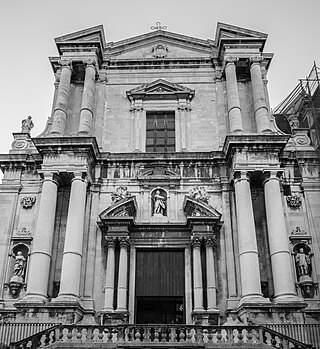
San Francesco Borgia is a Roman Catholic church located on Via Crociferi #7, adjacent to the former Collegio Gesuita, and parallel to San Benedetto, and about a block south on Crociferi of the church and convent of San Giuliano, in the city of Catania, region of Sicily, southern Italy. The church is mainly used for exhibits, but still holds much of the original Jesuit artwork.
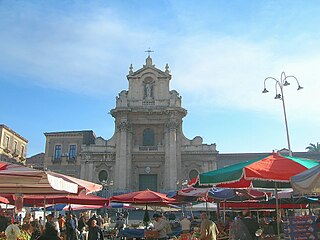
The Santuario della Madonna del Carmine also called Basilica di Maria Santissima Annunziata al Carmine, is a Roman Catholic minor basilica church and Marian sanctuary located on Piazza Carlo Alberto, in the town of Catania, Sicily.
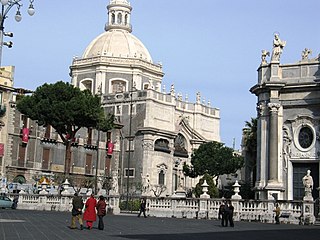
Badia di Sant'Agata or Abbey of St Agatha refers to an 18th-century Roman Catholic church and attached female convent located on Via Vittorio Emanuele #182 in the center of Catania, region of Sicily, southern Italy. The Baroque style church facade is across the street from the left transept of the Cathedral of Catania.
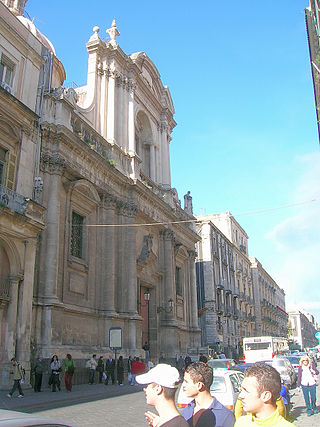
San Michele Arcangelo ai Minoriti is a Roman Catholic parish church and attached monastery in the city center of Catania, region of Sicily, Italy. The former monastery, to the left of the facade, now houses shops on the ground-floor, and above are the offices of the Provincial government and the Prefettura or Prefecture.
Santa Maria di Gesù is a Roman Catholic parish church located in Caltagirone in the region of Sicily, Italy. There is also a former Jesuit church del Gesù in town.

San Francesco d'Assisi is the Roman Catholic church and adjacent convent in the town of Enna, in the region of Sicily, Italy.
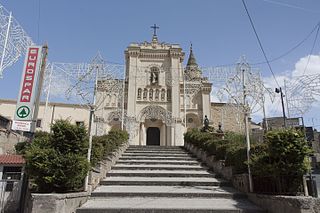
The church of the Abbey of San Filippo d'Agira is located in Piazza Abbazia #1 in the town of Agira, province of Enna, region of Sicily, Italy. It is also referred to as the Reale Abbazia or royal abbey.
San Francesco is a Roman Catholic church and convent located in the town of Tortorici, province of Messina, region of Sicily, Italy. The church was named a national monument. It stands diagonally across from the parish church of Santa Maria Assunta.

San Tommaso Apostolo is a Roman Catholic parish church located on the Piazza Francesco Paolo Neglia (also known as Piazza San Tommaso, and Via Roma in the town of Enna in Sicily, Italy. At a diagonal, across the street stands the church of Anime Sante del Purgatorio.



















